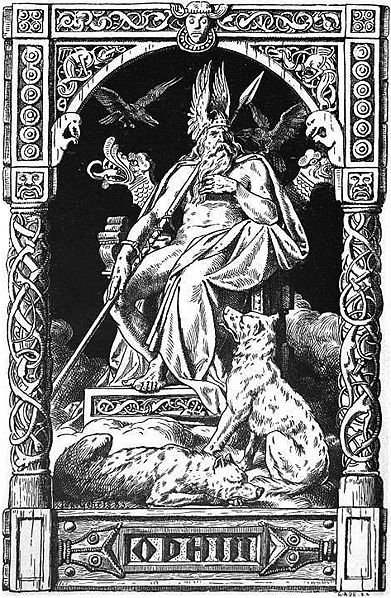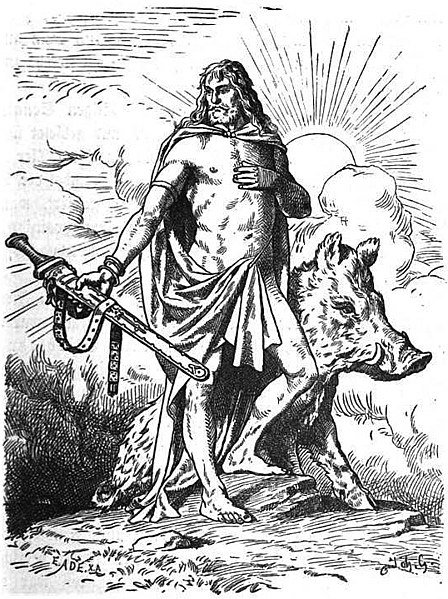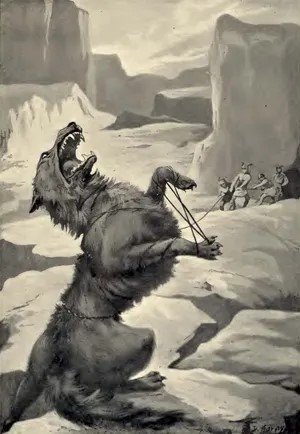Magical Objects Series - Part One: Norse Mythology
‘Odin’ by Arthur Rackham (W.Commons)
The research notes I’ve compiled over the years include quite a number of mythological objects, so I thought starting a series of magical objects from different mythologies might be a fun idea.
And given how insanely busy work has become, I welcome anything ‘fun’.
As there are lots of objects to choose from in each mythology, I’ll limit each list to 10.
I’ll start with Norse mythology.
For reasons known only to Loki, he cut off the hair of the goddess Sif who is associated with the earth.
Thor threatened to crush every bone in Loki’s body if he didn’t remedy the situation.
Loki went to the Sons of Ivaldi, who were dwarves, and they made 3 special items for him – golden hair to replace Sif’s hair, the ship Skíðblaðnir (featured further down), and the spear Gungnir.
Gungnir – Odin’s spear.
'Odhin' (1901) by Johannes Gehrts - Odin flanked by his ravens Huginn & Munnin, the wolves Geri & Freki, and holding the spear, Gungnir - Johannes Gehrts (W.Commons)
This spear was so well balanced, it could hit its target regardless of the strength and skill of the spear-thrower.
It is said in the Prose Edda, the Old Norse textbook written in the early 13th century, that, at Ragnarök, Odin will lead the Einherjar (the warriors who died in battle and reside in Valhalla) onto the battlefield where he will attack the wolf, Fenrir, with Gungnir.
Loki was so impressed with the items, he couldn’t stop praising the craftsmanship of the Sons of Ivaldi.
He wagered his head with the dwarf Brokkr, declaring the dwarf and his brother Eitri couldn’t possibly come up with 3 beautiful yet practical items.
Brokkr accepted the challenge.
He worked the bellows to keep the fire at the right temperature for Eitri to use his magic in the forging of three items: Mjöllnir, the ring Draupnir, and the golden boar Gullinbursti.
Draupnir – Odin’s ring.
Draupnir by jok-design.de (W.Commons)
This delicately crafted gold ring had the ability to multiply itself.
Every 9th night, 8 new rings would ‘drip’ from Draupnir, each one the same size and weight as the original, symbolizing Odin’s power and wealth.
Mjölnnir – Thor’s hammer.
'Thor' (1901) with Mjolnnir, the gloves Járngreipr & the belt Megingjord - Johannes Gehrts (W.Commons)
The first item created by Eitri and Brokkr, they didn’t simply make a hammer but infused it with the power to control thunder and lightning.
Mjöllnir, however, was more than a mighty weapon; it was also used as a divine instrument to deliver blessings.
While Odin, Thor, and Freyr judged the quality of the items made by the brothers, Brokkr explained Mjöllnir’s function:
‘Then he gave Thor the hammer and said he would be able to strike as heavily as he liked, whatever the target, and the hammer would not fail, and if he threw it at something, it would never miss, and never fly so far that it would not find its way back to his hand, and if he liked, it was so small that it could be kept inside his shirt. But there was this defect in it that the end of the hammer was rather short…’ – ‘Edda (Everyman’s Library)’ trans. by Anthony Faulkes.
Gullinbursti, the boar.
Freyr with his sword and the boar Gullinbursti - Johannes Gehrts (W.Commons)
The third and last thing the brothers created was the beautiful boar, Gullinbursti, fashioned entirely out of gold.
Able to glow, the boar could brighten even the darkest places.
Gullinbursti was gifted to Freyr, said to be the twin brother of the goddess Freya, and is associated with peace, prosperity, kingship, fair weather, and good harvest.
The next two items were given to Thor by the jötunn, Gríðr (or Grid), Odin’s consort and the mother of Víðarr the silent, the god associated with vengeance, who avenges his father’s death by killing the wolf, Fenrir, at Ragnarök.
On his way to face the challenge of the jötunn Geirröðr, Thor stops at Gríðr’s home, and she warns him of Geirröðr’s cunning, and equips him with her iron gloves, belt of strength, and her staff Gríðarvöl.
Járngreipr – Thor’s iron gloves.
The gloves allow Thor to better handle Mjöllnir, serving as a form of protection against the force with which the hammer flies back to the god, and the power it generates when he uses its magic.
Megingjörð – Thor’s belt of strength.
Gríðr’s belt doubles Thor’s already mighty strength.
The belt, the iron gloves and Mjöllnir are considered Thor’s most essential possessions.
Skíðblaðnir – the ship of Freyr.
One of the items made by the Sons of Ivaldi, the ship was said to be the best of ships in Norse mythology.
It always had a favourable breeze and could be folded up, like a piece of cloth, and carried in a pouch.
Sword of Freyr.
This sword could fight on its own ‘if wise be he who wields it’.
In the Prose Edda, Freyr asks Skírnir, his messenger and vassal, to bring the jötunn Gerðr to him for he loved her and wished to wed her.
But, first, Skírnir demands Freyr’s sword, and the god readily hands it over.
But, without his sword, Freyr will die at Ragnarök for he is fated to fight the fire-jötunn Surtr.
Gjallarhorn.
Heimdall with Gjallarhorn - Lorenz Frølich (W.Commons)
The horn is associated with the god Heimdall, the son of Odin and Nine Mothers, who possesses foreknowledge and is said to have exceptionally keen eyesight and hearing.
He keeps watch for invaders and the onset of Ragnarök from his dwelling where the rainbow bridge, Bifröst, meets the sky.
The sound of the Gjallarhorn will herald the beginning of Ragnarök.
Gleipnir, the chain that binds Fenrir.
Fenrir & Gleipnir (Britannica)
It was prophesied that the mighty wolf, Fenrir, and his family would, one day, be responsible for the destruction of the world.
While still a cub, the gods caught him and locked him in a cage where he was cared for by Tyr, the god of war.
When Fenrir had grown, twice the gods attempted to bind the wolf with chains of metal, but he broke free both times.
The gods then ordered the dwarves to forge a chain strong enough to hold Fenrir.
Using magic, the dwarves made the chain from 6 things that are now missing in the world because they were taken away to be part of the chain – the footsteps of a cat, the roots of a mountain, a woman’s beard, the breath of fishes, the sinews of a bear, and bird’s spittle.
Gleipnir was thin as a silk ribbon but stronger than any iron chain.
Fenrir would only agree to be bound by the chain if one of the gods put his hand in the wolf’s mouth as a gesture of goodwill.
When none stepped forward, Tyr, laughing, put his hand in Fenrir’s mouth.
But when the wolf realised he could not break Gleipnir, he bit Tyr’s hand off.
The gods chained Fenrir to a rock in the earth.
At Ragnarök, Fenrir will break Gleipnir and join the battle against the gods.
He will fight Odin and devour him.
Odin’s son, Víðarr, will kill Fenrir and avenge his father.
Odin and Fenris - Mabel Dorothy Hardy (Wikipedia)
As for the wager Loki had with the dwarf Brokkr – he lost the bet as the gods judged the work of the dwarf brothers to be superior.
But Loki kept his head as he wouldn’t allow Brokkr to have it, saying it would have damaged his neck, which hadn’t been included in the bet.
Brokkr still got some satisfaction as he sewed Loki’s lips shut so the god wouldn’t be able to brag about anything until the thread came out.







